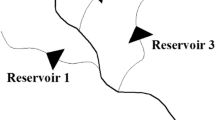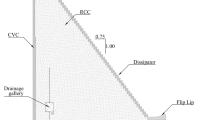Abstract
The problem of dam safety is one of the most important research topics of water conservancy projects, and many researchers pay much attention to study the risk of earth dam overtopping. This paper synthesizes in the definition of risk the probabilities of dam failure and the corresponding losses, including the probability estimation, losses evaluation and criteria exploring risk approaches. Then, a comprehensive risk assessment system of dam flood overtopping is established, which is widely applicable. Gate failure, randomness of flood, initial water level and time-varying effects are incorporated in the failure probability model. Many complex factors are simplified in losses estimation. In addition, thresholds of various types of losses are proposed and are adapted to the national conditions. The methodology is applied to the Lianghekou hydropower station in China to illustrate the assessment process of flood overtopping risk and to evaluate its safe loophole with a view to the failure of spillway gates. Monte Carlo simulation and JC method programs are adopted to solve the model based on MATLAB tools and DELPHI. The results show that the losses pose significant impact on the risk assessment and should be considered in the assessment of risk. Probability calculation and loss estimation could be well combined with standards, providing a basis for risk management and decision-making.










Similar content being viewed by others
References
ANCOLD (1994) Guidelines on risk assessment. Australian committee on large dams, Sydney
ANCOLD (2003) Guidelines on risk assessment. Australian committee on large dams, Sydney
Chadwick WL (1976) Chairman of independent peal to review cause of Teton dam, failure of Teton dam. Report to US Department of the Interior and State of Idaho, Idaho
de Béjar LA (2011) Probability of flood-induced overtopping of barriers in watershed-reservoir-dam systems. J Hydrol Eng © ASCE 9:699–709
Dekay ML, McClelland GH (1993) Predicting loss of life in case of dam failure and flash flood. Risk Anal 2:193–205
Fan Z, Jiang S (2005) Application of tolerance risk analysis method in decision-making of flood prevention. J Hydraul Eng 36(5):618–623
Fan Z, Jiang S (2007) Researches on time-varying risk rate for flood control of dams. J Hydraul Eng 38(supply):168–173
Graham WJ (2001) A simple procedure for estimating loss of life from dam failure. RES CDAM-LOL Helsinki 6(19):1–7
He X, Sun D, Huang J (2008) Assessment on social and environmental impacts of dam break. Chin J Geotech Eng 30(11):1752–1757
Hege K (1997) Dam safety evaluation and risk analysis. Exp Water Res Hydropower Inf 18(9):1–6
Hsu Y, Tung Y, Kuo J (2011) Evaluation of dam overtopping probability induced by flood and wind. Stoch Environ Res Risk Assess 25:35–49
Hydrochina Xibei Engineering Corporation (2008) Design specification for rolled earth-rock fill dams. National Development and Reform Commission, China
ICOLD (1998) ICOLD guidelines on risk assessment for dams. Attachment by: Williams, A: ICOLD chairman’s 1997/1998 progress report for New Delhi meeting, vol 11, pp 1–28
Jiang S, Fan Z (2006) Influence of time varying effect on flood control risk rate for dams. J Hydraul Eng 37(4):425–430
Jin Y (2008) Study on the analysis approach for the dangerous situations of dam breach. Hohai University, Nanjing
Kreuzer H (2000) The use of risk analysis to support dam safety decisions and management. ICOLD 20th Congress, Beijing
Kuo J, Yen B, Hsu Y et al (2007) Risk analysis for dam overtopping-Feitsui reservoir as a case study. J Hydraul Eng ASCE 8:955–963
Kwon H, Moon Y (2006) Improvement of overtopping risk evaluations using probabilistic concepts for existing dams. Stoch Environ Res Risk Assess 20:223–237
Li S (2011) Key technology research and system development of dam safety risk management. Tianjin University, Tianjin
Li L, Wang R, Sheng J et al (2006) Dam risk evaluation and risk management. China water conservancy and hydropower press, Beijing
Li C, Wang S, Wang W et al (2012) Overtopping risk analysis using LHS-MC method. J Hydroelectr Eng 32(1):5–9
Lou JK (2000) Dam safety risk management of Canada BC Hydro corporation. Dam Saf 4:7–11
Ma R (2004) Risk analysis methods and applications of earth-rock dam. Science Press, Beijing
Mo C, Liu F (2010) Study on evaluation method for overtopping risk degree of reservoir earth dam. J Hydraul Eng 41(3):319–324
Mo C, Liu F, Yu M et al (2008) Risk analysis for earth dam overtopping. Water Sci Eng 6(1):76–87
Rettemeier K, Falkenhagen B, Köngeter J (2000) Risk assessment—new trends in Germany. The proceedings of 21th international congress on large dams. The international commission on large dams, Beijing, pp 625–641
Shi G, Zhu H, Xun H (1998) Study on reservoir dam-break loss and its calculation methods. J Catastrophol 13(4):28–33
Sun Y, Huang W (2005) Risk analysis on overtopping for operation management of reservoir. J Hydraul Eng 36(10):1153–1157
USCOLD (1988) Committee on failures and accidents to large dams. Lessons from Dam Incidents, USA, ASCE, New York
Yang S, Pan Y, Dong J et al (2013) A systematic approach for the assessment of flooding hazard and risk associated with a landslide dam. Nat Hazards 65:41–62
Zhang S, Yan L (2011) Operation safety risk analysis method of hydropower project considering time-dependent effect. Eng Sci 13(12):51–55
Zhang S, Sun B, Yan L et al (2013) Risk identification on hydropower project using the IAHP and extension of TOPSIS methods under interval-valued fuzzy environment. Nat Hazards 65:359–373
Zhong D, Sun Y, Li M (2011) Dam break threshold value and risk probability assessment for an earth dam. Nat Hazards 59:129–147
Zhou K (2006) Study on the analysis method for loss of life due to dam breach dissertation. Nanjing Hydraulic Research Institute, Nanjing
Zhu H, Chen Z, Zhou Z (2003) Risk analysis on dam overtopping of Taihe Reservoir. Dam Saf 4:11–14
Acknowledgments
The authors gratefully appreciate the supports from the State Key Laboratory of Hydraulic Engineering Simulation and Safety (Tianjin University, China), the Foundation for Innovative Research Groups of the National Natural Science Foundation of China (No. 51021004), the National Natural Science Foundation of China (No. 51379141), and Tianjin Research Program of Application Foundation and Advanced Technology (No. 13JCYBJC19400). In addition, thanks to Wenqi Sa, Ting Zhang and Man Li for their data processing in this research project.
Author information
Authors and Affiliations
Corresponding author
Rights and permissions
About this article
Cite this article
Zhang, S., Tan, Y. Risk assessment of earth dam overtopping and its application research. Nat Hazards 74, 717–736 (2014). https://doi.org/10.1007/s11069-014-1207-3
Received:
Accepted:
Published:
Issue Date:
DOI: https://doi.org/10.1007/s11069-014-1207-3




